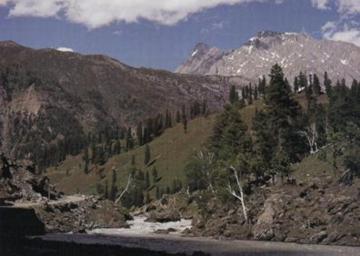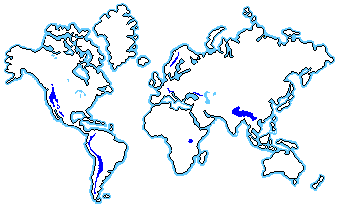

Cold, snowy, windy. When you hear those words they make you think of mountains. The Alpine biome is like winter is to people in New England; snow, high winds, ice, all the typical winter things. In Latin the word for 'high mountain' is 'alpes'. That is where today's word alpine comes from.
Alpine biomes are found in the mountain regions all around the world. They are usually at an altitude of about 10,000 feet or more. The Alpine biome lies just below the snow line of a mountain. As you go up a mountain, you will travel through many biomes. In the North American Rocky Mountains you begin in a desert biome. As you climb you go through a deciduous forest biome, grassland biome, steppe biome, and taiga biome before you reach the cold Alpine biome.
In the summer average temperatures range from 10 to 15° C . In the winter the temperatures are below freezing. The winter season can last from October to May. The summer season may last from June to September. The temperatures in the Alpine biome can also change from warm to freezing in one day.
Because the severe climate of the Alpine biome, plants and animals have developed adaptations to those conditions. There are only about 200 species of Alpine plants. At high altitudes there is very little CO2, which plants need to carry on photosynthesis. Because of the cold and wind, most plants are small perennial groundcover plants which grow and reproduce slowly. They protect themselves from the cold and wind by hugging the ground. Taller plants or trees would soon get blown over and freeze. When plants die they don't decompose very quickly because of the cold. This makes for poor soil conditions. Most Alpine plants can grow in sandy and rocky soil. Plants have also adapted to the dry conditions of the Alpine biome. Plant books and catalogs warn you about over watering Alpine plants.
Alpine animals have to deal with two types of problems: the cold and too much high UV wavelengths. This is because there is less atmosphere to filter UV rays from the sun. There are only warm blooded animals in the Alpine biome, although there are insects. Alpine animals adapt to the cold by hibernating, migrating to lower, warmer areas, or insulating their bodies with layers of fat. Animals will also tend to have shorter legs, tails, and ears, in order to reduce heat loss. Alpine animals also have larger lungs, more blood cells and hemoglobin because of the increase of pressure and lack of oxygen at higher altitudes. This is also true for people who have lived on mountains for a long time, like the Indians of the Andes Mountains in South America and the Sherpas of the Himalayas in Asia.
No comments:
Post a Comment